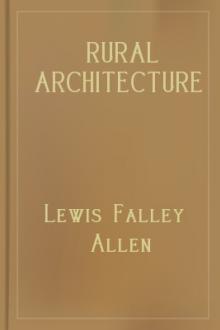Rural Architecture by Lewis Falley Allen (accelerated reader books .txt) 📖

- Author: Lewis Falley Allen
- Performer: -
Book online «Rural Architecture by Lewis Falley Allen (accelerated reader books .txt) 📖». Author Lewis Falley Allen
In the wash-room are two windows. A chimney at the far end accommodates a boiler or two, and a fireplace, if required. A sink stands adjoining the chimney. A flight of stairs, leading to a garret over head on one side, and to the kitchen chamber on the other, stands next the dairy, into which last a door also leads. In this wash-room may be located the cooking stove in warm weather, leaving the main kitchen for a family and eating room. A door also leads from the wash-room into the wood-house.
The wood-house stands lower than the floor of the wash-room, from which it falls, by steps. This is large, because a plentiful store of wood is needed for a dwelling of this character. If the room be not all wanted for such purpose, a part of it may devoted to other necessary uses, there seldom being too much shelter of this kind on a farm; through the rear wall of this wood-house leads a door into the garden, or clothes-yard, as the case may be; and at its extreme angle is a water closet, 6×4 feet, by way of lean-to, with a hipped roof, 8 feet high, running off from both the wood-house and workshop. This water-closet is lighted by a sliding sash window.
On to the wood-house, in a continuous front line, joins the workshop, an indispensable appendage to farm convenience. This has a flight of stairs leading to the lumber-room above. For the furnishing of this apartment, see description of Design I. Next to the work-house is the wagon and tool-house, above which is the hay loft, also spread over the stable adjoining; in which last are stalls for a pair of horses, which may be required for uses other than the main labors of the farm—to run to market, carry the family to church, or elsewhere. A pair of horses for such purposes should always be kept near the house. The horse-stalls occupy a space of 10×12 feet, with racks and feeding boxes. The plans of these will be described hereafter. The door leading out from these stalls is 5 feet wide, and faces the partition, so that each horse may be led out or in at an easy angle from them. Beyond the stalls is a passage 4 feet wide, leading to a store-room or area, from which a flight of rough stairs leads to the hay loft above. Beyond this room, in which is the oat bin for the horses, is a small piggery, for the convenience of a pig or two, which are always required to consume the daily wash and offal of the house; and not for the general pork stock of the farm; which, on one of this size, may be expected to require more commodious quarters.
The chamber plan of this house is commodious, furnishing one large room and three smaller ones. The small chamber leading to the deck over the porch, may, or may not be occupied as a sleeping room. The small one near the stairs may contain a single bed, or be occupied as a large clothes-closet. Through this, a door leads into the kitchen chamber, which may serve as one, or more laborers' bed-chambers. They may be lighted by one or more windows in the rear gable.
If more convenient to the family, the parlor and sitting-room, already described, may change their occupation, and one substituted for the other.
The main business approach to this house should be by a lane, or farm road opening on the side next the stable and wagon-house. The yard, in front of these last named buildings, should be separated from the lawn, or front door-yard of the dwelling. The establishment should stand some distance back from the traveled highway, and be decorated with such trees, shrubbery, and cultivation, as the taste of the owner may direct. No general rules or directions can be applicable to this design beyond what have already been given; and the subject must be treated as circumstances may suggest. The unfrequented side of the house should, however, be flanked with a garden, either ornamental, or fruit and vegetable; as buildings of this character ought to command a corresponding share of attention with the grounds by which they are surrounded.
This house will appear equally well built of wood, brick, or stone. Its cost, according to materials, or finish, may be $1,000 or $1,500. The out-buildings attached, will add $400 to $600, with the same conditions as to finish; but the whole may be substantially and well built of either stone, brick, or wood, where each may be had at equal convenience, for $2,000 in the interior of New York. Of course, it is intended to do all the work plain, and in character for the occupation to which it is intended.
MISCELLANEOUS DETAILS.At this point of our remarks a word or two may be offered on the general subject of inside finish to farm houses, which may be applicable more or less to any one, or all of the designs that may come under our observation; therefore what is here said, may be applied at large. Different sections of the United States have their own several local notions, or preferences as to the mode of finish to their houses and out-buildings, according to climate, education, or other circumstances. In all these matters neither taste, fashion, nor climate should be arbitrary. The manner of finish may be various, without any departure from truth or propriety—always keeping in mind the object for which it is intended. The material for a country house should be strong, and durable, and the work simple in its details, beyond that for either town or suburban houses. It should be strong, for the reason that the interior of the farm house is used for purposes of industry, in finishing up and perfecting the labors of the farm; labors indispensable too, and in amount beyond the ordinary housekeeping requirements of a family who have little to do but merely to live, and make themselves comfortable. The material should be durable, because the distance at which the farm house is usually located from the residences of building mechanics, renders it particularly troublesome and expensive to make repairs, and alterations. The work should be simple, because cheaper in the first place, in construction, and finish; quite as appropriate and satisfactory in appearance; and demanding infinitely less labor and pains to care for, and protect it afterward. Therefore all mouldings, architraves, chisel-work, and gewgawgery in interior finish should be let alone in the living and daily occupied rooms of the house. If, to a single parlor, or spare bedchamber a little ornamental work be permitted, let even that be in moderation, and just enough to teach the active mistress and her daughters what a world of scrubbing and elbow work they have saved themselves in the enjoyment of a plainly-finished house, instead of one full of gingerbread work and finery. None but the initiated can tell the affliction that chiseled finishing entails on housekeepers in the spider, fly, and other insect lodgment which it invites—frequently the cause of more annoyance and daily disquietude in housekeeping, because unnecessary, than real griefs from which we may not expect to escape. Bases, casings, sashes, doors—all should be plain, and painted or stained a quiet russet color—a color natural to the woods used for the finish, if it can be, showing, in their wear, as little of dust, soiling, and fly dirt as possible. There is no poetry about common housekeeping. Cooking, house-cleaning, washing, scrubbing, sweeping, are altogether matter-of-fact duties, and usually considered work, not recreation; and these should all be made easy of performance, and as seldom to be done as possible; although the first item always was, and always will be, and the last item should be, an every-day vocation for somebody; and the manner of inside finish to a house has a great deal to do with all these labors.
In a stone, or brick house, the inside walls should be firred off for plastering. This may be done either by "plugging," that is, driving a plug of wood strongly into the mortar courses, into which the firring should be nailed, or by laying a strip of thin board in the mortar course, the entire length of each wall. This is better than blocks laid in for such purpose, because it is effectually bound by the stone, or brick work; whereas, a block may get loose by shrinking, but the nails which hold the firring to the plug, or to the thin strip of board will split and wedge it closer to the mason work of the outside wall. This is an important item. It makes close work too, and leaves no room for rats, mice, or other vermin; and as it admits a space—no matter how thin—so that no outside damp from the walls can communicate into, or through the inner plastering, it answers all purposes. The inside, and partition walls should be of coarse, strong mortar, floated off as smoothly as may be, not a hard finish, which is fine, and costly; and then papered throughout for the better rooms, and the commonly-used rooms whitewashed. Paper gives a most comfortable look to the rooms, more so than paint, and much less expensive, while nothing is so sweet, tidy, and cheerful to the working rooms of the house as a lime wash, either white, or softened down with some agreeable tint, such as light blue, green, drab, fawn, or russet, to give the shade desired, and for which every professional painter and whitewasher in the vicinity, can furnish a proper recipe applicable to the place and climate. On such subjects we choose to prescribe, rather than to play the apothecary by giving any of the thousand and one recipes extant, for the composition.
Our remarks upon the strength and durability of material in house-building do not apply exclusively to brick and stone. Wood is included also; and of this, there is much difference in the kind. Sound white oak, is, perhaps the best material for the heavy frame-work of any house or out-building, and when to be had at a moderate expense, we would recommend it in preference to any other. If white oak cannot be had, the other varieties of oak, or chesnut are the next best. In light frame-timbers, such as studs, girts, joists, or rafters, oak is inclined to spring and warp, and we would prefer hemlock, or chesnut, which holds a nail equally as well, or, in its absence, pine, (which holds a





Comments (0)